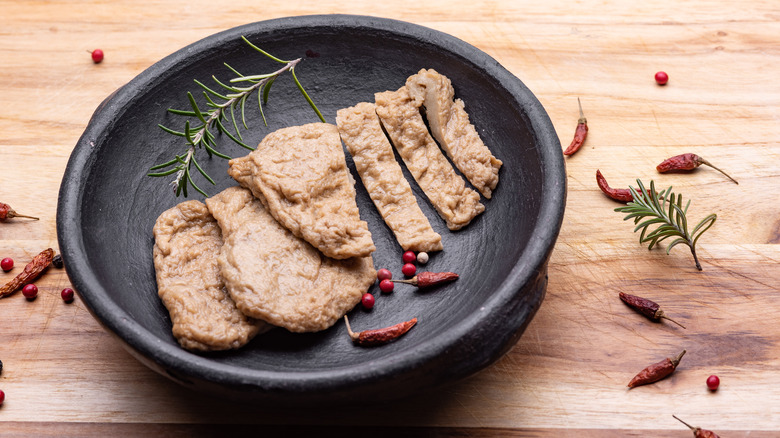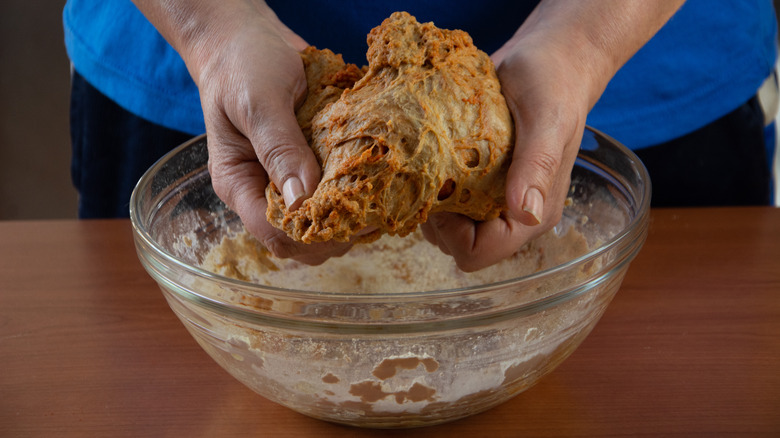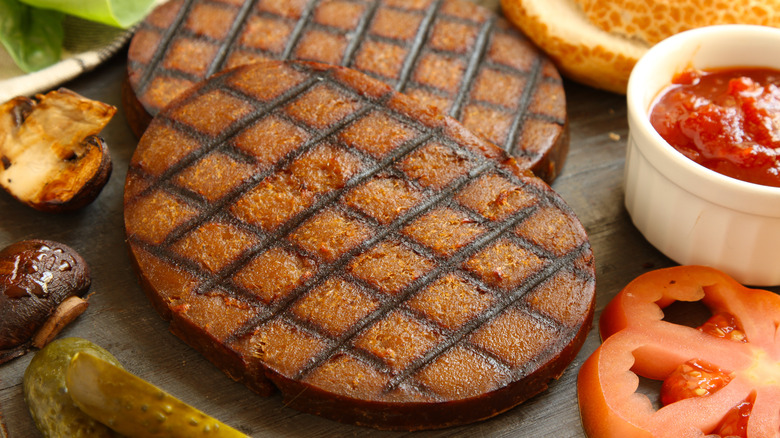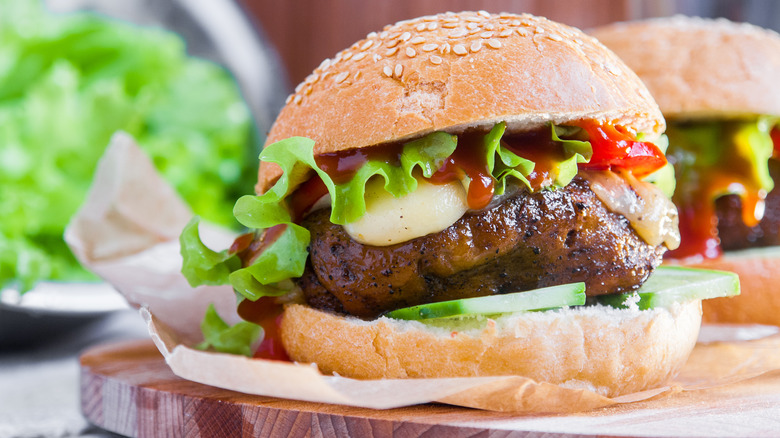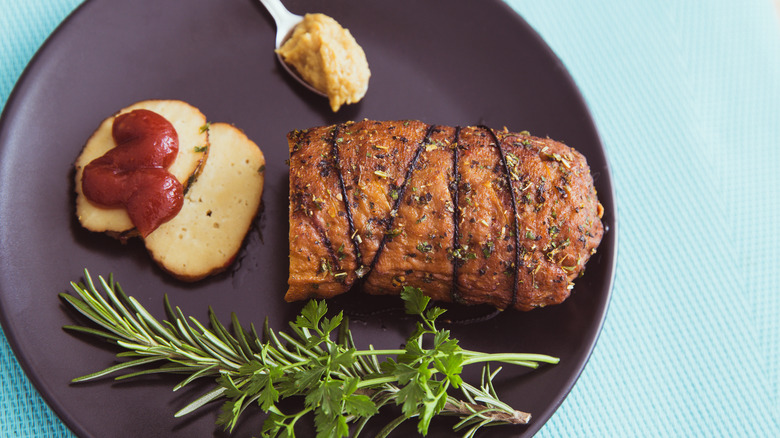What Is Seitan And What Does It Taste Like?
If you follow a vegan or vegetarian diet and frequently eat plant-based meats like soy burgers and pulled jackfruit, you may have already heard of seitan — one of the few vegan-friendly substitutes for meat. It's a popular choice as it looks like and has a similar texture to animal meat, and it's considered to be low in carbs and high in protein.
Seitan (pronounced "say-tan") is also popularly referred to as "wheat meat." That's because seitan is made solely from wheat and water and, as such, it is entirely made of gluten. The article further notes that seitan's gluten content can be a cause of concern for anybody that is sensitive to or intolerant of wheat and gluten or has celiac disease. So, before you decide whether or not you should start incorporating seitan in your diet, there are many important things about this alternative meat to consider.
What is seitan and how is it made?
Seitan has been around for centuries in China and Japan and was originally developed as a substitute for meat by Buddhist monks who followed a vegetarian diet, according to Smithsonian Magazine. Unlike other vegetarian proteins tofu and tempeh, both of which are made from soybeans, seitan is made from wheat and that's important because, like dough, it's very elastic and has great texture for lots of chewing satisfaction.
Seitan can be made one of two ways. The first is by using a special kind of flour known as vital gluten wheat, which is very finely powdered with very little starch. However, seitan can also be made by kneading regular wheat flour under a stream of water to wash away the starches, leaving behind a sticky mass of pure gluten protein. It's for this reason why seitan is also called wheat gluten, wheat protein, or simply just gluten. Once you have the dough handy, seasonings such as soy sauce can be added before it is cooked.
Also, the trick to seitan's texture is in the kneading of the dough. If you knead it more, then more gluten will be formed, and more gluten formation will result in an end product that is more chewy and elastic.
What does seitan taste like?
Since seitan is essentially just a dough made out of wheat, it has a very mild flavor profile on its own, if any at all, like that of bland chicken or portobello mushrooms. However, seitan's lack of flavor is also one of its greatest advantages. Since seitan is quite bland itself, it's a very versatile protein that you can season however you like, and it will absorb pretty much anything you season it with, from curry to buffalo sauce or a steak marinade.
Because of its depth of possibilities, you can easily use seitan as a plant-based substitute in a number of recipes that call for meat. In an interview with Eat This, Not That!, Kylie Sakaida of Nutrition by Kylie says that it's great to marinate and bake like a steak, or you can use it for a flavorful broth or stew. Other options include using a food processor to grind it and create a quasi ground beef, bread and fry it like chicken strips, "or brush with BBQ sauce and grill it to make ribs." Other options include cutting it into strips for fajitas or cubing it for skewers on the grill. The options are really endless.
It's also believed that seitan's popularity is really more because of its texture than its taste. Seitan has a noticeable hearty texture that really mimics animal meat unlike other plant-based meat substitutes like tofu and tempeh that are softer.
Why is seitan so expensive?
Plant-based meats in general can be pricier than more traditional options. Even though a lot more goes into producing animal meat than plant-based meats — animals need to be fed, taken care of, and transported, which also requires more grain feed, water, and energy — veggie options are still more costly, for now anyway. That's because plant-based meats are manufactured on a much smaller scale than animal meats, which keeps things like beef and chicken more affordable for the consumer.
Vox also points out that, unlike the plant-based industry, the federal government heavily subsidizes the animal agriculture industry to keep the cost of animal meat more affordable. This is despite the fact that seitan is so easy to produce that you can even make it at home by buying a bag of wheat gluten and following any number of recipes online to make it yourself.
In the future, this could very well change. As plant-based eating becomes more and more common, and demand goes up, prices will go down. In recent months, both Impossible Foods and Beyond Meat, made public their plans to lower their prices as they increase and optimize production. Much of it driven by the fact that fast food chains like Burger King are now carrying their products for veggie-friendly menu options that have driven new popularity.
Is seitan better for you than tofu?
Seitan is very high in protein — a 3-ounce serving contains anywhere between 15 to 21 grams, says Healthline. Tofu, on the other hand, has about 8 grams of protein in every 3.5-ounce serving, Healthline notes in another article. So when it comes to protein, seitan ranks higher than tofu by a longshot.
However, the website further notes that seitan does not contain enough lysine, an essential amino acid that a human body must get from food. This is why seitan is not considered to be a complete protein. To compensate, you can add lysine-reach foods like beans into your diet. On the flip side, tofu contains all the essential amino acids that a human body requires and, as such, it's considered to be a complete protein.
Another point to consider when choosing between tofu and seitan are allergies. For anybody with soy allergies, tofu is not an option and so seitan is a great choice. Though, for people with wheat and gluten allergies or celiac disease, seitan should definitely be avoided, making tofu the better choice.
